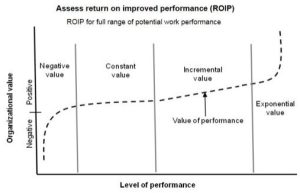To capture the full potential of integrating automation into the workplace, leaders need to understand its impact on work and the organization.
All too often, leaders approach workplace automation from a purely technological perspective, becoming mired in endless discussions on how machines will replace humans. But to decide how to best automate work requires a more nuanced perspective. It’s essential to consider how work and automation will evolve. Instead of framing the issue as one of wholesale job replacement, organizations need to find the optimal combinations of humans and machines.
To determine how to best combine human and automated work requires leaders to radically rethink how work gets done. For the past 150 years, work has been done in “jobs.” Beginning with the Third Industrial Revolution, work started to move beyond the boundaries of the organization through outsourcing, which involves transferring intact processes (i.e., all jobs in a process) to a service provider. And now in the Fourth Industrial Revolution, work is escaping beyond the construct of a job.
Today, work is being deconstructed into elemental tasks and reconstructed into reinvented jobs. Some of the tasks within these jobs may be best completed using automation solutions while others may require not only FTEs but contingent workers including temps, freelancers and independent contractors.
Given the constant evolution of work and technology, optimizing work automation requires the perpetual reinvention of jobs. But how can organizations systematically navigate a world where work is constantly upgraded and reconfigured?
The reinventing jobs framework
The following four-step framework, based on our work with clients over the past 10 years, can help guide leaders in organizations solve how to best combine humans and machines.
Step 1: Deconstructing jobs
Many leaders tend to think of jobs as fixed repositories of competencies, tasks, performance indicators and reward packages. Unfortunately, this view can obscure opportunities to unlock value from automation because it is only when jobs are deconstructed into tasks that the true potential of work automation is understood.
Any number of sources can help with the work of breaking down jobs into component tasks or work elements: job descriptions, performance goals, and online tools such as the O*NET database. Once job deconstruction is completed, organizations need to assess which tasks are amenable to automation. It can help to group tasks into three different categories: repetitive vs. variable, independent vs. interactive, and physical vs. mental.
As an example, consider how tasks associated with a bank teller’s job might be categorized and evaluated for their automation compatibility. Some tasks are repetitive (e.g., providing requested cash) while others are variable (e.g., recommending additional banking services). Certain tasks can be performed independently (e.g., processing a withdrawal and debiting a customer’s account) while others require human interaction and emotional intelligence (e.g., counseling customers with insufficient funds). Additionally, some tasks are physical (e.g., counting and giving cash to customers) and others mental (e.g., collaborating with bank product designers).
Our work has shown that tasks that have the following dimensions are most suited for substitution by automation: repetitive, rules-based tasks that are performed primarily independently. Tasks in the bank teller job such as counting and giving cash fit this pattern and can be automated using ATMs. At the same time, it becomes clear which tasks must be done by humans or augmented by automation. For example, those that are variable, interactive and mental such as recommending banking services.
This first step – deconstructing jobs and analyzing automation compatibility – lays the foundation for optimally applying automation.
Step 2: Assessing the payoff
Organizations next need to determine where automation will deliver the most pivotal payoff. After all, not all improved work performance delivers the same value. Automating certain tasks may improve quality, in other cases it may reduce risk of underperformance and in still other instances automation may reduce variance.
How then do organizations determine the relationship between work performance and value to the organization, the return on improved performance (ROIP)? Through our work, we’ve identified four prototypical ROIP curves as shown in the illustration.
The vertical axis shows the value of work performance to the organization while the horizontal axis represents the level of performance. The shape of the curve shows the ROIP for each of the four segments.
Let’s use the example of tax accounting to illustrate how these curves work:
Negative value — The left section of the figure shows the return on improved performance ranging from low to minimally acceptable levels. This curve illustrates the significant negative value when performance falls below a certain minimum standard. Underperformance here could have significant consequences.
Constant value — In the second section from the left, performance differences – better or worse performance — all deliver the same value above a certain level. In the case of tax form preparation, this would include completing tax forms before or at the deadline date. Completing the form significantly ahead of the deadline date produces no additional value than completing it just before the due date. Better or worse performance here delivers little strategic value.
Incremental value — The third section illustrates the case where each improvement in performance delivers an incremental increase in strategic value. In the area of tax preparation, a clear, well-written summary letter that goes beyond the required basic explanation and calls attention to critical highlights delivers incremental value to the client and the organization.
Exponential value — The far-right section of the figure illustrates an ROIP range where improved performance delivers exponential value. Performance in this range is rare and can involve instances of far exceeding a customer’s expectations. For instance, a tax preparer might uncover an obscure tax deduction that can significantly reduce the amount of tax owed.
Once an organization has deconstructed jobs into component tasks and determined the ROIP for those tasks, it is prepared to make decisions about the role of various automation options.
Step 3: Identifying work automation options
The following well-established automation categories can help leaders clarify their options:
Robotic process automation — The most mature of the three technologies, robotic process automation (RBA), is used to automate high volume, low complexity and routine business tasks. Examples of these include the updating of employee payroll data, or the transferring of data from one software program to another such as from a spreadsheet to a CRM system.
Cognitive automation (AI) including machine learning and natural language processing — This technology is used in non-routine, complex, and often exploratory tasks. It is especially effective at recognizing patterns in big data. For example, auto insurers use cognitive automation to analyze thousands of claims to identify locations most prone to accidents and adjust premiums depending on whether one is driving in high-risk or low-risk locations.
Social robotics — This technology involves the use of robots that combine sensors and AI to interact with people in routine and non-routine collaborative tasks. Examples of social robots include driverless cars and autonomous drones.
Step 4: Optimizing work automation
The first three steps – deconstructing jobs, determining the ROIP of various tasks and identifying automation options – are brought together in the fourth step, which involves determining how to optimally combine human and automated work. Each of the aforementioned types of automation is suited to different types of work tasks, and will deliver a different impact – substituting, augmenting or creating new activities – and ROIP.
Going back to the example of the bank teller, process automation can be used to verify account balances thereby substituting automation for human work, and avoiding mistakes (ROIP). Cognitive automation can be used to identify and recommend new services to clients thereby augmenting the work of humans and delivering incremental value. And in other areas, cognitive automation can create new types of work – for example supporting customers as they engage with the bank remotely and potentially delivering exponential value.
The following examples illustrate how this might work:
The Coca-Cola Company had a strategic goal to produce its Simply Orange juice with a consistent taste profile regardless of where oranges were sourced. This involved product design and development work, which is variable, independent and mental. In the past, human procurement planners had not been able to gather and analyze crop and weather data quickly enough to affect product quality or supply. As a result, the quality of the product was inconsistent. In addition, there was significant variation in product quantity due to slow or inappropriate reactions to changing weather conditions.
To address these issues, the organization turned to cognitive automation in the form of its Black Book Model algorithms that were used to predict weather patterns and expected crop yields. Cognitive automation augmented the work of human procurement planners who now have far more accurate and rapid recommendations. This approach increased the value of the planners’ performance exponentially, resulting in improved product quality and accelerated product development.
Work automation is also enabling the insurance industry to reinvent jobs such as that of the claims adjuster. Some insurance companies are using social robotics in the form of collaborative drones to assess storm damage in areas that are dangerous or inaccessible. Instead of doing the hazardous work of assessing damage at sites in these areas, claims adjusters now spend time analyzing the data collected by their drone collaborators, resulting in faster claims decisions.
While these examples focus on individual jobs, work automation often has knock-on effects on multiple jobs and can reshapes entire teams.
Implications for organizations and their leaders
Organizations stand to reap many benefits from reinventing jobs. By deconstructing jobs, applying automation to specific tasks and reconstructing that work into new types of positions, organizations can realize average savings of 60-80%, a significant increase when compared to the 25-30% savings that typically results from outsourcing. Moreover, reinventing jobs to optimize work between humans and machines can deliver non-economic gains – for example, attracting a larger, more qualified applicant pool, which contributes to better retention and greater diversity.
In addition, reinventing jobs requires a new type of leadership. Leaders become orchestrators of an ever-evolving work ecosystem of different work options. They must collaborate with workers in new ways as work is constantly upgraded and help workers acquire new skills to keep up. Interestingly, the 2018 Willis Towers Watson Future of Work Survey showed that the two areas where organizations were most unprepared are “Deconstructing jobs and identifying which tasks can best be performed by automation,” and “Identifying reskilling pathways for talent whose work is being transformed by automation.” Yet these two areas are critical to achieving the optimal combinations of humans and automation.
Ultimately, it will be the leader’s responsibility to make the decisions about how, when and where to apply automation to substitute, augment or create new work. Using our framework, leaders can build a work-automation strategy that will guide them as they rethink work and identify the optimal human-machine combinations that can unlock value for their organizations.
